9: Writing Systems
- Page ID
- 114829
Writing Systems, from Sarah Harmon
Video Script
Let's talk writing systems! We can't talk about the history of language without talking about writing systems, and, yes, part of this is going to cover historic writing systems or writing systems that have been used across the history of human language. But we can't do this without also bringing in the modern writing systems, especially having to do with the smart phone.
Let's start off by talking about the hierarchy, if you will, of certain reading systems. When we say hierarchy, we're not saying one is better over another, or that one is preferred one over another. Frequently, what we're saying is something is more iconic versus more alphabetic; we're creating a spectrum. It is interesting to know that, with a couple of exceptions, you are talking about a historic evolution of writing over human language history.
When we talk about, for example, ideograms or specifically cave drawings or petrographs, we're talking about the earliest instance of humans trying to put something about what they want to say in a written format. From there, these pictographs evolve frequently into iconographs, where an icon doesn't just represent the thing that obviously it represents—that it maybe represents a sound or a syllable or versions thereof. The two best examples are Egyptian Hieroglyphics and Mayan Hieroglyphics. There are a slew of videos on YouTube, recent documentaries and examples of hieroglyphics, both in Egyptian and Mayan languages. These documentaries showcase how they have evolved over time, where you saw a picture of a bull that literally only meant ‘bull’—a little bit more pictographic—to what it turned out to be—the term for ‘bull’ in Egyptian, whatever that sound was, that symbol started representing the sound, not just the meaning. It was really cool.
From there we get cuneiform, which is what we see with Sumerian, and then that gets borrowed by a few other generations and few other cultures, principally the Akkadian culture and the Hittite culture. Cuneiform is really the first instance of a written language with non-representational characters. If you think about a hieroglyph, they represent the thing; if you see a picture of a bowl, it's going to represent a bowl, along with other items. When we think about cave drawings or ideograms or even emoticons, these are pictures that represent a concept. When you get to cuneiform—and specifically Sumerian cuneiform—they are literal wedges. Those combinations of wedges represent a sound; at that point, you're getting to a writing system that represents sound and less meaning.
From there we go into a syllabary and then frequently an alphabet. There are a number of not just historic languages, but modern languages, that use either a syllabary or an alphabet. We have some ancient examples, like Phoenician, Ancient Greek and Latin—Old Latin along with later Classical and Vulgar Latin. When we talk about Japanese or Korean, or we start talking about Hindi or Cyrillic or Pinyin or Abjads, now we're talking about modern language and modern writing. It has changed over time. For example, abjads have a connection to the writing system for Sanskrit, which itself has been the basis of a number of writing systems for various languages, not just the Indo-Aryan languages, but also a number of the Afro-Asiatic languages. Chinese is listed here is a syllabary, but not the way you think; the Chinese characters themselves are representations of syllables. The way we think about the Chinese writing system now it is technically a syllabary, and then Pinyin is the Latin-based representation that's more alphabetic. Korean has an interesting combination; it's technically an alphabet, but it acts like a syllabary. so there's ways to play with this.
There are variations to writing systems. We talked about abjads earlier; these are a writing system where the main symbol is a consonant, and then you have certain diacritics being vowels. We mostly think of the Semitic languages—Arabic and Hebrew as the two principal languages—using abjad syllabaries. It is based off of the writing systems that you see with Sanskrit and some of the other Indo-European languages of South and Central Asia. They have a fascinating history, and if you want to learn more just let me know, and I can send you some references.
Then you have Japanese, which can be seen as a bit confusing if you are not Japanese. There is not one nor two, but four different writing systems. In fact, I didn't put one of them up here; it's actually five. Kanji is the one that probably you know about; kanji are based off of Chinese characters that are very similar to traditional Chinese characters. They were in use from the earliest stages of Japanese; in fact, if you can read kanji, you have a pretty good idea of what the Chinese writing system says. It is still very formal, and there are, to my knowledge, very few if any new kanji being created. It is more a reference to certain characters that are word-based, and they frequently have to do with something very similar that you hear in Mandarin or one of the Chinese languages. Then you have the kana. The kana are the syllabary; there's two different versions of it: hiragana and katakana. Hiragana are always the native Japanese terms, and it's more formal; katakana are loan words. If you pick up anything that is written in Japanese, and you see a mix of characters, it's almost always going to be one of these two kana. It will be a mix, depending on whether the lexicon is a native Japanese word or if it's a borrowed word. The one I forgot to put up here is romanji, which is Latin alphabet spelling of everything.
Korean technically has an alphabet but it's written out as clusters or syllables, so it's almost like a syllabary.
When we talk about diacritics, this is also an interesting important piece, especially to the Latin writing system—many of the languages that you use and know of use a Latin writing system, like English. Most of the Indo-European languages of Europe, though not all, use the Latin rating system. A number of them use Cyrillic., and there is a separate writing system for Armenian and Greek.
Digraphs: This might be a term you've heard before. Digraphs are two symbols that combine; think about a couple of those sibilants that we have an English: [ʃ, tʃ]. While we write the sound using two different symbols in the writing system ‘sh’ or ‘ch’. The same thing with that velarized nasal, that [ŋ] sound frequently spelled with two letters; the combination of them we know to represent a specific sound. We do this with vowels, as well.
Examples of Writing Systems
Let's take a look at some of these writing systems. I'm going to show you combined Cyrillic and Ancient Greek; you might find that to be confusing, but there's a reason
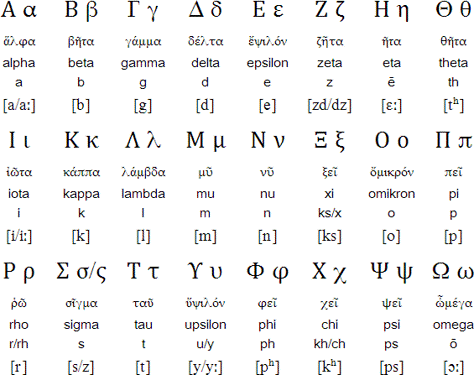
On the right side is Ancient Greek, and Modern Greek is a variety of this.
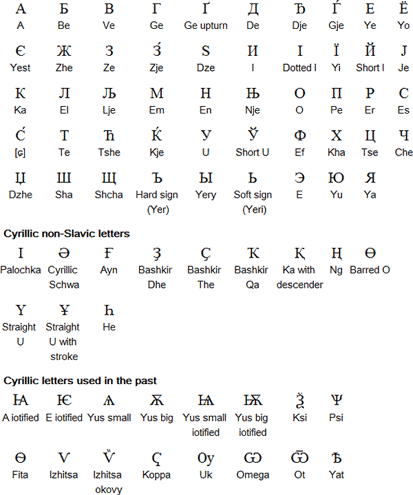
Cyrillic is based off of a more modernized Middle Greek. If you notice the letter for that ‘a’, it's just like alpha. The B and V sounds are based off of beta. There are specific symbols that you see that came out of the Ukrainian or Russian branch of the Slavic language family. I phrase it that way because Ukrainians say they came up with Cyrillic first, and the Russian say they came up with it first; I am going to split the difference and say, Ukraine or Russian area of Slavic. We have a number of Slavic letters that get borrowed throughout the Slavic languages. It is interesting to note that some Slavic languages have moved away from Cyrillic, especially given the fall of the Soviet Union.
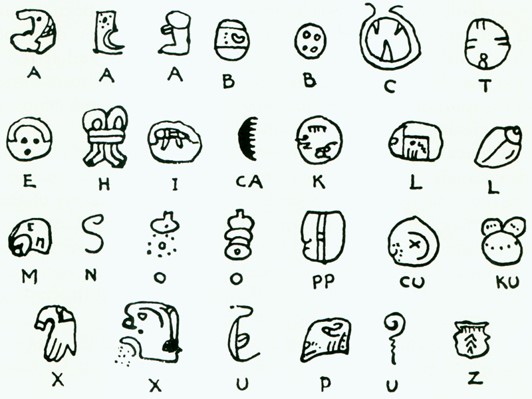
It is important to show hieroglyphics; you have seen Egyptian hieroglyphics many times; these are the Mayan ones. We're still trying to decipher these; what you see here are the ones that we have deciphered. There are so many more to come, and many, many more that we're still trying to work on.

I love showing folks Phoenician because in many ways it’s an example of taking a later version of Egyptian hieroglyphs and changing them. There was a really fascinating documentary that was released in about how the ancient Egyptian hieroglyphs morphed, and the late hieroglyphs was almost identical to the Phoenician alphabet. Phoenician, to be fair, was a syllabary; it combined these symbols into syllable combinations. However, this is the basis for the Greek alphabet, so we frequently say that it is an alphabet, even though technically it's more of a syllabary. Notice that it is also a symbol that represents a concept. I brought up the concept of bull for a hieroglyph meaning not just an actual bull but the sound that that might also represent. If you turn your head to the side, as it were, or spin that icon for ‘aleph’ so that the point is down, it looks kind of like a bull; not surprisingly, the term ‘aleph’ in Phoenician meant ‘ox’. There's a real connection to this; as I said, there's a full documentary on this.
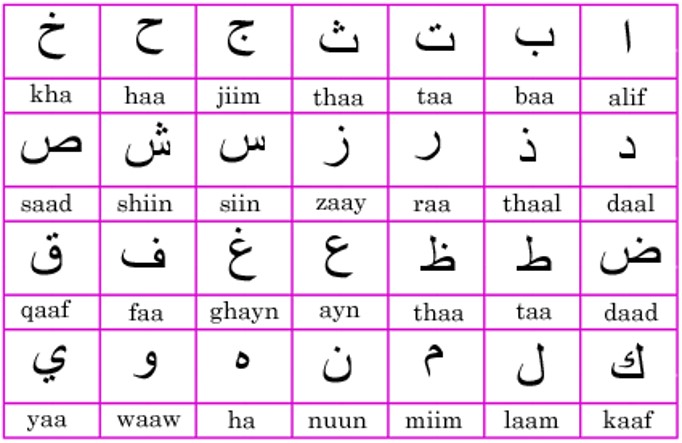
I brought up abjads before; this is Arabic in the graphic. Arabic symbols are not just the actual main symbol; it is the diacritic that goes with it—the little dots or dashes. The abjad system has many more symbols. Abjads are syllabaries, because it is not just a consonant or a vowel; it's a combination, an entire syllable. Notice that most of these are onset and nucleus, not as many codas on here.
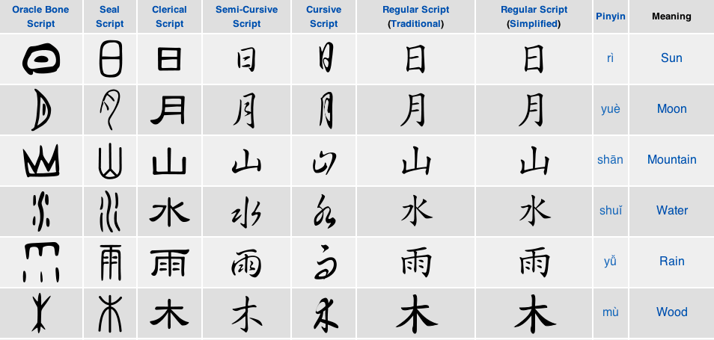
I love this graphic; I have no idea where I got it, but I love it. It is a history of the Chinese writing system. These symbols on the right are the earliest forms, and they go back about 4,000 years. From the Oracle Bone Script and Seal Script, and then when you start getting into Clerical Script, you're talking about old Chinese. Starting with Clerical Script, you see more systematic representations, going on to Regular Simplified Script that is used today in most of China and many, many parts of the diaspora. In Taiwan and a few other places, you tend to use Traditional Script, but you can start seeing the similarities from Clerical Script onwards, and to a lesser extent with the Seal Script. But they get less and less iconic; Oracle Bone Script is very highly iconic at this stage, and start getting more and more abstract, with more and more of a syllabary-type concept. Over here on the left, by the way, is the Pinyin, the Latin writing system that represents the sounds.
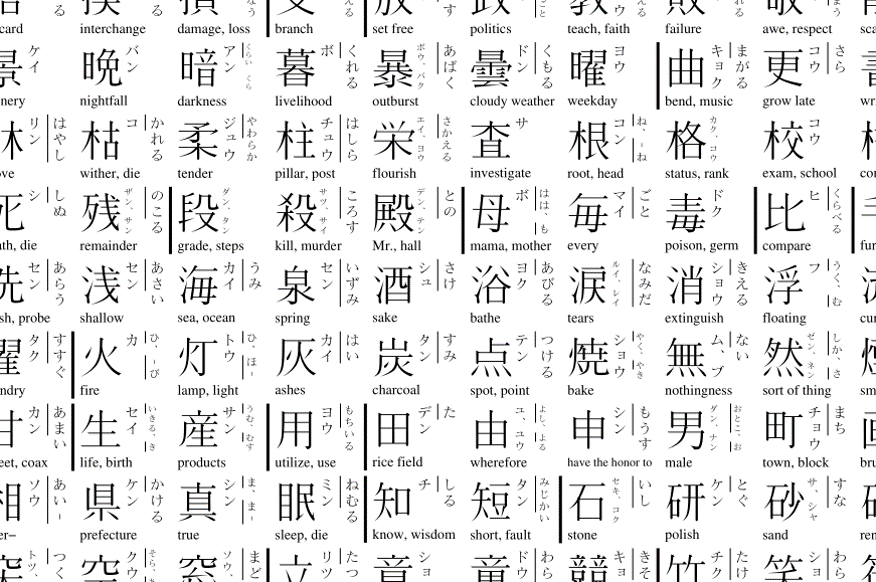
Thinking back to the Chinese Traditional and Cursive Scripts, compare those with kanji. Now you can see the connection between kanji and either Cursive or Regular Script; Depending on the country depends on which one is a little bit closer. You can see the very straight connections between kanji and the Chinese writing system. It is very straightforward, to the point that, like I said, if you can read kanji, you can get a pretty good idea of what is being said in the Chinese writing system just based on that connection.
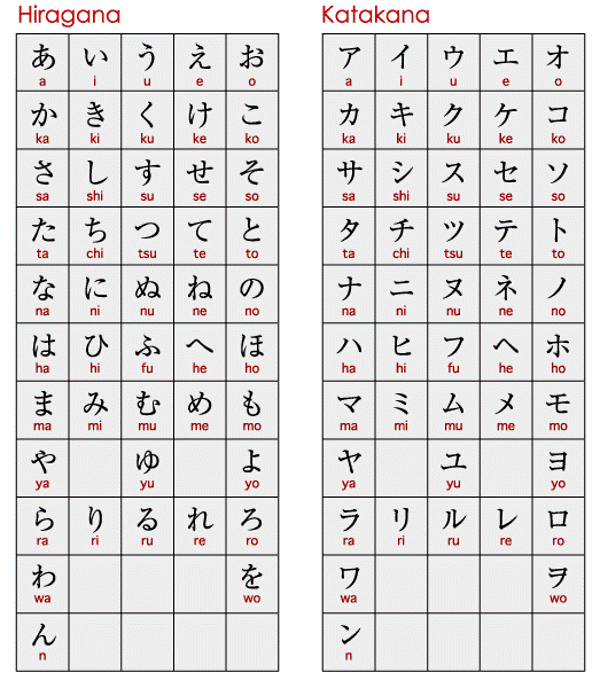
Compare kanji to kana. We have hiragana, which is for traditional and native Japanese terms, and then katakana, which is for borrowed terms.
A quick story: One of my very good friends from childhood is Japanese, and after college she moved back to Japan. She's very Japanese, and when I got married to my Japanese-American husband, who's half Japanese and half American, his last name is Smith. Jokingly my friend Mika sent me a gave me a new name: ‘sumisu-sama’. ‘Sama’ is, if you don't know in Japanese it is ‘ma'am’ or ‘madame’; it's very high-ranking term, and is frequently used for married women, especially if your family is from a higher echelon of Japanese society. ‘San’ is the one you're probably more familiar with, and that can be used as well, but ‘sama’ is a little bit higher still. So, she called me ‘sumisu-sama’, which just bowled me to see how she wrote it: in katakana, because Smith is not native Japanese. She also called me 'Maehara-sama'; 'Maehara' is hiragana, because it would be traditional, an old Japanese last name. It's one of the last names of my mother-in-law. (She actually should have used the kanji for Maehara, but she didn’t know it.)
As you can see, it’s not exactly kanji; it is very different. The kana are much more simplified; they are based off of kanji originally, but severely simplified.
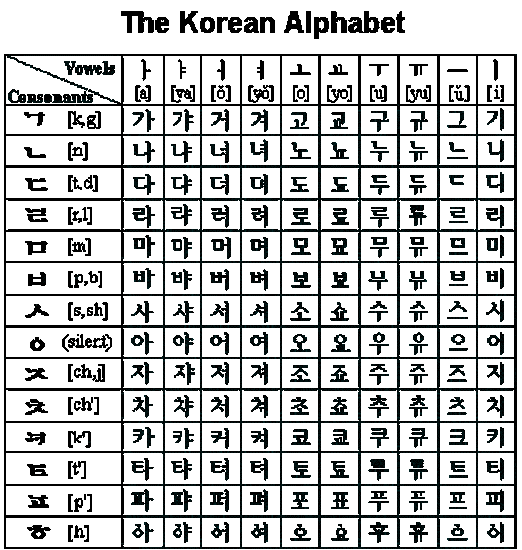
This is an example of the Korean alphabet. We say it is an alphabet but it's also a syllabary, because it's always a combination of a consonant and a vowel. For example, this is the symbol for [k, g], and you combine it with the vowel that goes with it, and you see those vowels here. The Korean alphabet, or hangul as it's called, is only about 100 years old; less than 150 years ago they switched to this writing system; before that they had a different writing system that was based off of the Chinese writing system.
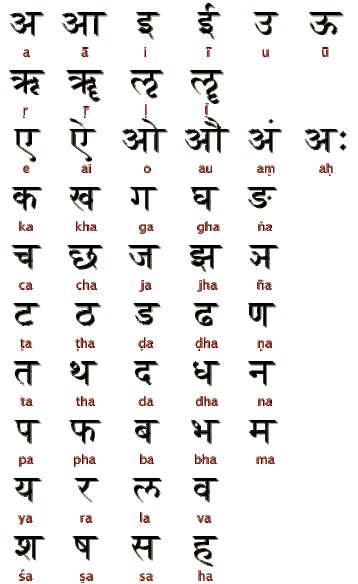
When we talked about Arabic abjads, I said that there's a connection to Sanskrit. Hopefully, you can see a little bit of a here; this is the Hindi alphabet. A number of the Indic languages use a version that was originally based off the Sanskrit. (I couldn't find a really good graphic that I liked for Sanskrit so that's why I don't have it here.) With Hindi, you can see some similarities, where there is a main character along with certain diacritics. But it is evolved, so while this is not an object, you can see the connections, and there's a stronger still connection to ancient Sanskrit.
Punctuation
This is to write sounds and letters, but that's not the only part of a writing system. Clearly, we have to also include punctuation. In modern written languages, we have to include punctuation; you need to know when we stop and when we start. It's one of the frequent frustrations of the transcripts from these videos is there's bad or no punctuation.
Punctuation is a modern concept; it is not ancient. In fact, one of the challenges when you read a script or a document that is more than a couple hundred years old, is the punctuation is either not there or it's inconsistent; there isn't much in the way of standardization.
Writing in general is archaic, meaning that we always keep an older pronunciation with respect to how we write a term. English is not the only example of this, and you saw with the Great Vowel Shift a strong example of this, but it's not the only one. We also have reform spelling, which happens in a number of writing systems, English included. Reform spelling is when a linguistic society reverts back to a supposed previous pronunciation or spelling. In the case of debt, at no point in the English language was it [dɛbt]; there was no [bt] spoken in the history of English language with respect to that lexicon.
Text-speak
Speaking of punctuation and writing, let's do text speak. It is probably the bane of most English teachers’ and professors’ existence. Most feel that it's only been around for about 20 years; in fact, it's been around for longer than that. The use of acronyms, for example, is thousands of years old; as long as we have had an alphabet, we have had acronyms. In most languages, there's always acronyms of some kind. Once we started having instant communication, like on smartphones, computers and the like, this is changed rapidly to the point that I remember when FML l didn't just stand for ‘fuck my life’, it also was ‘fuck my luck’, getting that rhyming in there.
Sometimes we are using acronyms to create a euphemism—WTF being a great example of that. I'll give you an example with LOL: I remember when we started using these text-speak acronyms, I used to use LOL a lot, and I used to ‘loller’ a lot . My mom did not for the longest time have the same concept of LOL; it wasn't ‘laugh out loud’, because for her it stood for ‘little old lady’. Acronyms will change from speech community to speech community and across generations. There were several artists in the late 70s and early 80s that frequently used numbers or truncation to express the same thing in written language. For example, instead of saying ate, they wrote the number 8. Whether it was the four or for, it was always written with the numeral 4. Again, this is not new; humans have been doing this as long as we have had a written language, and certainly alphabets, in particular, seem to lend themselves to this truncation more easily.
Emoji! Let's talk about emoji and all these various things that we love about texting.
When we talk about text speak, we cannot be prescriptive, we have to remain objective and descriptive. There have been a number of complaints that text speak is ruining our lives, that we don't know how to write anymore, because we only think about life in however many characters we have in our text box. No, this isn't the case. Prescriptivists will do this; they will say, “Raaaaaar my God there totes is an effect!!! What the fuck-Oh my gawd-BBQ!!” (Sorry folks, I've been doing text speak for a long time.) The truth of the matter is that isn't the case; linguists, remember, describe what happens, and we can describe a number of things. When you work on your term paper, if you choose the language and tech option, one of the papers you're going to read is by Hawley Turner, who in 2009 had a very important study. She showed that if you teach writing and texting as different registers, much like we do with different dialects and different registers different modes of communication. If you teach students in that same way, they absolutely can split out that difference of when you have to use formal writing, and when you can use text speak, emojis, etc. It's an important reminder.
Language changes all the time. All aspects of language change all the time, and that includes the writing system. How generations from now will not only speak the language, but write the language that you're fluent in, that will change.
Are you willing to change?
8.9.2 More on Lost (?) Writing Systems (optional)
Watch this TedEd video in which Susan Lupack discusses the race to decode what (we think) is Linear B, the ancient written language that the Minoans may have used. (The video is captioned.)
Next, watch this TedEd video in which Jesse Byock explains what we know about Viking runestones. (The video is captioned.)
Next, watch this YouTube video in which Cecilia Pardo of the British Museum explains the khipu system that the Incan Empire (and their predecessors) used as both a record keeping device...and a writing system? Really interesting! (The video is captioned.)

